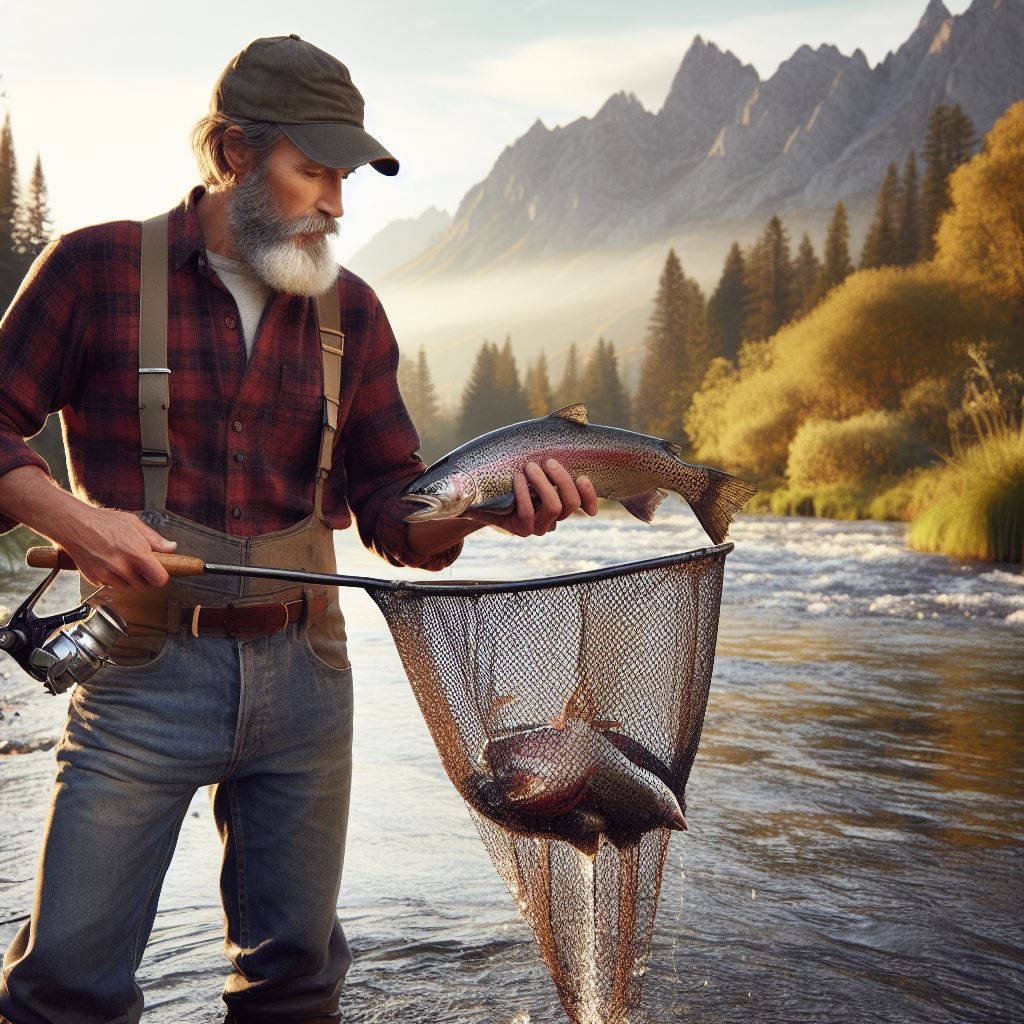Introduction
The United States boasts a rich marine ecosystem, teeming with a diverse array of fish species that have long captivated anglers and commercial fishermen alike.
From the depths of the Atlantic Ocean to the serene waters of the Pacific, the pursuit of these aquatic treasures has become an integral part of American culture and a testament to the nation’s deep-rooted connection to the sea.
In this exploration of popular fish species targeted by US fishermen, we’ll embark on a journey across the country’s diverse coastlines, delving into the unique characteristics and fishing techniques associated with these sought-after catches.
From the iconic striped bass of the Northeast to the elusive redfish of the Gulf Coast, we’ll uncover the stories behind these prized fish, unraveling their significance in the world of American fishing.
Join us as we navigate through the intricacies of fish species selection, exploring the factors that influence fishermen’s choices, from personal preferences to market demands.
Along the way, we’ll uncover the sustainable fishing practices that ensure the continued abundance of these marine resources for generations to come.
Types of Fish Species
Discuss popular saltwater fish species targeted by US fishermen
- Tuna: A large and powerful fish known for its speed and endurance in the open ocean.
- Marlin: A prized sport fish with a long bill and a reputation for its acrobatic leaps.
- Snapper: A group of fish species found in both shallow and deeper waters, known for their tasty flesh.
- Grouper: These bottom-dwelling fish species are highly sought after for their delicious meat.
Discuss popular freshwater fish species targeted by US fishermen
- Bass: Widely pursued game fish famous for its aggressive nature and impressive fighting abilities.
- Trout: Sought after by anglers for their beauty, these fish thrive in cool, clear waters.
- Pike: A ferocious predator known for its sharp teeth and ambush hunting style.
- Catfish: Bottom-dwelling species characterized by their barbels and popular for their tasty flesh.
Highlight the diversity of fish species targeted by US fishermen
Whether in saltwater or freshwater, US fishermen enjoy a vast array of fish species.
From the lightning-fast tuna and acrobatic marlin to the tasty snapper and grouper, the excitement never ceases.
In freshwater bodies, the aggressive bass, graceful trout, formidable pike, and delectable catfish provide endless thrills.
The biodiversity of fish species in American waters is staggering.
Each species exhibits unique characteristics, behaviors, and habitats.
Anglers embrace the challenge of targeting different fish, adapting their techniques and equipment accordingly.
Saltwater fishing in the US offers an abundant variety of fish species.
Tuna, known for their remarkable speed, provide an adrenaline rush for anglers.
The marlin, famous for its majestic leaps, demands strength and skill.
Snapper, found in shallow and deep waters, entice with their succulent flesh.
Grouper, lurking on the seabed, reward fishermen with their excellent taste.
Freshwater fishing in the US is equally captivating.
Bass angling is a favorite pastime, with this feisty fish
often leaping out of the water to snatch lures.
Trout, living in pristine rivers and lakes, captivate with their vivid colors.
Transform Your Career Today
Unlock a personalized career strategy that drives real results. Get tailored advice and a roadmap designed just for you.
Start NowPike, ruling the waters with their predatory instincts, delight those who seek thrills.
Catfish, known for their scavenging habits, provide a delectable culinary option.
The diversity of fish species targeted by US fishermen reflects the country’s vast aquatic ecosystems.
From coast to coast, anglers can explore a wide range of fish habitats, each with its own enchanting aquatic life.
Overall, US fishermen have the privilege of targeting a remarkable variety of fish species.
The saltwater realm presents opportunities to pursue species like tuna, marlin, snapper, and grouper, each with their own allure.
Meanwhile, the freshwater world offers the thrilling pursuit of bass, trout, pike, and catfish, each
providing its own unique experience.
The diversity of fish targeted by US fishermen ensures endless excitement and exploration for anglers across the country.
Read: Safety Protocols and Training for American Fishermen
Fishing Methods and Locations
Different Fishing Methods Used to Catch Popular Saltwater Fish Species
Each of these methods is applied in a specific way to target different saltwater fish species.
For example, trolling is often used to catch species like marlin and tuna, which are known for their migratory behavior and tendency to swim near the surface.
Bottom fishing is effective for catching species like grouper and snapper, which are typically found near the ocean floor.
Deep-sea fishing is ideal for species like swordfish and mahi-mahi, which inhabit deeper waters.
Different Fishing Methods Used to Catch Popular Freshwater Fish Species
These various methods are applied to specific freshwater fish species.
Casting is commonly used for species like bass and pike, as it allows for accurate placement of lures in shallow areas.
Fly fishing is popular for trout and salmon, as the artificial flies mimic natural insects found in their habitat.
Ice fishing allows anglers to target species like perch and walleye, which are active during colder months and reside in frozen bodies of water.
Popular Fishing Locations in the US for Each Fish Species
- Coastal Areas: Atlantic coast for species like striped bass and bluefish; Gulf of Mexico for redfish and snook.
- Lakes: The Great Lakes for trout and salmon; Lake Okeechobee for largemouth bass.
- Rivers: the Colorado River for trout; the Mississippi River for catfish.
- Specific Regions: Pacific Northwest for salmon; Florida Keys for tarpon; Cape Cod for cod.
These fishing locations are known for their abundance of specific fish species.
Coastal areas provide opportunities for targeting saltwater species, while lakes are home to a variety of freshwater fish.
Rivers offer diverse fishing opportunities depending on the region, and certain areas are famous for particular species.
Transform Your Career Today
Unlock a personalized career strategy that drives real results. Get tailored advice and a roadmap designed just for you.
Start NowIt is important for fishermen to research and choose the right location for their desired fish species.
Read: Impact of Climate Change on US Fishing Grounds

Regulations and Sustainability
The Role of Regulations in the Fishing Industry
- Fishing regulations are crucial for managing fish populations and ensuring their long-term sustainability.
- These regulations help prevent overfishing and maintain ecosystem balance.
- Restrictions on catch limits and seasons ensure that fish populations have time to replenish.
- Size limits enable fish to reach reproductive maturity and sustain their population.
Federal and State Fishing Regulations in the US
- Federal regulations, established by agencies like the National Oceanic and Atmospheric Administration (NOAA), oversee fishing in federal waters.
- State regulations, enforced by individual states, manage fishing activities in their respective coastal waters.
- These regulations may differ between states based on their unique fishery needs.
- States often work alongside federal agencies to ensure effective management and cooperation.
The Concept of Sustainable Fishing
- Sustainable fishing practices are essential for the long-term survival of both fisheries and the ecosystems they depend on.
- By focusing on sustainability, fishermen and ecosystems can benefit in various ways.
- Sustainable fishing maintains healthy fish populations, ensuring a continued source of income for fishermen.
- Ecosystems are protected from overexploitation, preserving the balance of marine life.
Initiatives Promoting Sustainable Fishing in the US
- One important initiative is the implementation of catch shares, where fishermen are allocated a specific percentage of the quota.
- This approach promotes accountability and prevents overfishing, as fishermen have a direct stake in maintaining the fishery’s sustainability.
- Catch shares also reduce wasteful bycatch and foster innovation in fishing practices.
- By providing economic incentives for sustainable practices, fishery improvement projects can drive positive change.
- Certification programs, like the Marine Stewardship Council (MSC), promote sustainable fishing practices through third-party audits.
- These certifications assure consumers that the seafood they purchase has been sourced responsibly, benefitting both fishermen and the environment.
Regulations play a crucial role in the fishing industry, ensuring the long-term sustainability of fish populations and maintaining ecosystem balance.
Federal and state regulations work hand in hand to manage fishing activities effectively.
Sustainable fishing practices benefit both fishermen and ecosystems by guaranteeing a continuous source of income and protecting marine biodiversity.
Initiatives such as catch shares and certification programs promote sustainability and accountability within the industry.
Through these efforts, the US fishing industry can thrive while preserving the oceans for future generations.
Read: The Cultural Significance of Fishing in American Society
See Related Content: How U.S. Foresters Aid in Forest Fire Prevention
Economic Importance
Fishing plays a vital role in the US economy.
The economic impact of popular fish species targeted by US fishermen is substantial.
Economic Impact of Popular Fish Species
The revenue generated from commercial fishing activities is a significant contributor to the economy.
Commercial fishermen catch popular fish species, both for domestic and international markets, driving revenue and sustaining the growth of related industries.
In addition to commercial fishing, recreational fishing also plays a vital role in stimulating local economies.
Anglers who participate in recreational fishing contribute significantly to the tourism industry in coastal areas.
Revenue from Commercial Fishing
The revenue generated from commercial fishing activities accounts for billions of dollars annually.
This revenue not only supports the livelihoods of fishermen but also drives economic growth in coastal communities.
Contribution of Recreational Fishing
Recreational fishing, including activities like sport fishing and charter fishing, also adds to the economic value of popular fish species.
Tourists and fishing enthusiasts spend money on charters, equipment, bait, lodging, and other related services, boosting local economies.
Employment Opportunities in the Fishing Industry
Aside from the economic impact, the fishing industry offers various employment opportunities.
Transform Your Career Today
Unlock a personalized career strategy that drives real results. Get tailored advice and a roadmap designed just for you.
Start NowJobs Related to Fishing
Jobs directly related to fishing include commercial fishermen, who venture out into the oceans to catch.
popular fish species for commercial purposes. These individuals play a crucial role in the industry’s success.
Charter boat captains, another essential part of the fishing industry, offer recreational fishing experiences to tourists and fishing enthusiasts.
They contribute to local economies by providing guided tours and sharing their expertise.
Owners of bait and tackle shops also benefit from the fishing industry.
These businesses provide fishing equipment, bait, and other supplies to both commercial and recreational fishermen, generating revenue and supporting local economies.
Ripple Effect on Other Sectors
The fishing industry has a ripple effect on other sectors of the economy.
It stimulates growth in industries such as hospitality, tourism, boat manufacturing, and marine equipment manufacturing.
This ripple effect creates additional job opportunities and fosters overall economic development.
To summarize, the popular fish species targeted by US fishermen have significant economic importance.
The revenue generated from commercial fishing activities, as well as the contribution of recreational fishing, play a crucial role in local economies.
Furthermore, the fishing industry provides employment opportunities in various sectors, supporting economic growth in coastal communities.
Read: How Overfishing Affects US Waters and Solutions Ahead
Conclusion
Popular fish species targeted by US fishermen play a crucial role in the economy and food security.
It is essential to prioritize sustainable fishing practices to prevent overfishing and preserve fish populations.
I encourage readers to explore fishing opportunities while supporting responsible fishing techniques, ensuring the longevity of our marine ecosystems.
The diverse marine ecosystems off the US coast provide an abundance of fish species, making it a popular destination for recreational and commercial fishing.
Anglers and commercial fishermen alike target a variety of fish species, each with its own unique characteristics and culinary appeal.
From the iconic striped bass to the delectable halibut, the fish species targeted by US fishermen offer a taste of the ocean’s bounty.
Recreational fishing, in particular, has gained immense popularity, with millions of Americans taking to the waters each year to pursue their favorite fish species.
Transform Your Career Today
Unlock a personalized career strategy that drives real results. Get tailored advice and a roadmap designed just for you.
Start NowThe thrill of the catch, the connection with nature, and the satisfaction of providing a fresh meal for the table are just a few of the reasons why fishing remains a cherished pastime.
However, as we enjoy the fruits of the ocean, we must also be mindful of the delicate balance of marine ecosystems.
Responsible fishing practices, such as observing catch limits and using proper gear, are essential to ensuring the sustainability of our fisheries for future generations.
The fish species targeted by US fishermen are not just a source of food and recreation;
they are also an integral part of the marine environment.
By understanding and appreciating these species, we can better appreciate the importance of conserving our oceans and ensuring a healthy future for marine life.
[E-Books for Sale]
The Big Book of 500 High-Paying Jobs in America: Unlock Your Earning Potential
$19.99 • 500 High-Paying Jobs • 330 pages
Explore 500 high-paying jobs in America and learn how to boost your career, earn more, and achieve success!
See All 500 High-Paying Jobs of this E-Book
1001 Professions Without a Degree: High-Paying American Jobs You Can Start Now
$19.99 • 1001 Professions Without a Degree • 174 pages
Discover 1001 high-paying jobs without a degree! Unlock career tips, skills, and success strategies for just $19.99!




